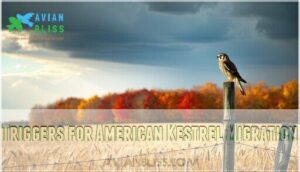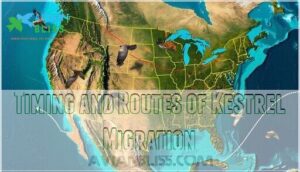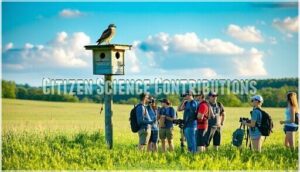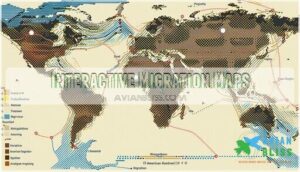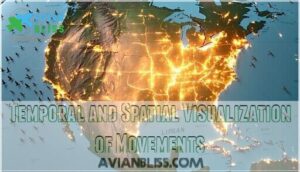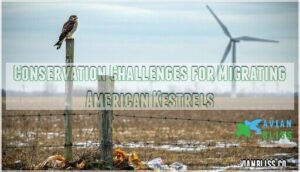This site is supported by our readers. We may earn a commission, at no cost to you, if you purchase through links.
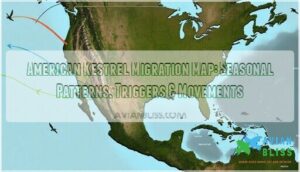
Patterns emerge—birds from the north embarking on marathon flights, while their southern cousins skim only a few hundred miles below the radar. It’s a seasonal spectacle mapped in movement, driven by changing resources, constantly changing landscapes, and a species’ relentless need to adapt. Track their migration and you’ll glimpse resilience written across the continent.
Table Of Contents
- Key Takeaways
- American Kestrel Migration Patterns and Seasonal Movements
- Triggers for American Kestrel Migration
- Timing and Routes of Kestrel Migration
- Flight Behavior During American Kestrel Migration
- Wintering Grounds of American Kestrels
- Genetic Insights Into American Kestrel Migration
- Mapping American Kestrel Migration Movements
- Conservation Challenges for Migrating American Kestrels
- Future of American Kestrel Migration Research
- Frequently Asked Questions (FAQs)
- What is Kestrel migration?
- How far do American kestrels travel during migration?
- Do kestrels migrate in winter?
- Do American kestrels follow fixed routes?
- Are kestrels obligate latitudinal migrants?
- Are kestrels adapting to changing climate patterns?
- Where do American Kestrels migrate to?
- Where do kestrels migrate to in the winter?
- Are American Kestrels declining?
- What is the incubation period for American kestrel?
- Conclusion
Key Takeaways
- American Kestrel migration patterns vary widely, with some birds traveling thousands of miles while others remain mostly local or shift only slightly in elevation.
- Migration timing and routes are shaped by a mix of environmental cues, food availability, and body condition, with northern birds typically migrating farthest.
- Stopover sites and winter habitats are chosen for abundant prey and safety, with both migrants and resident kestrels sometimes sharing territories and resources.
- Conservation efforts are increasingly urgent as habitat loss, climate change, and human-made hazards disrupt traditional migratory paths and wintering grounds.
American Kestrel Migration Patterns and Seasonal Movements
The American Kestrel moves through the seasons with a flexibility that might surprise you. Their patterns take many forms, shaped by where they live and what they need.
Here’s a closer look at the different ways kestrels move as the year unfolds.
Latitudinal Migration
When autumn settles in and days grow shorter, American Kestrels set their sights on warmer horizons, tracing ancient pathways from northern forests to sunlit southern skies. This north-south movement spans vast distances, with breeding latitude determining how far each bird travels.
As autumn darkens, American Kestrels journey from northern forests to warm southern skies, guided by the distances their birthplace dictates
Kestrels nesting in Canada might journey thousands of miles to reach their winter range, while those from southern populations barely budge. Migration patterns reveal fascinating population differences—northern birds are long-distance migrants, southern ones stay put year-round.
Altitudinal Migration
Not all kestrels chase the horizon line—some simply follow the seasons up and down the nearest peak. Altitudinal migration means these birds shift elevations on mountainsides rather than traveling hundreds of miles southward. When winter chill sweeps high-altitude breeding grounds in ranges like the Appalachian Mountains, American kestrels descend to warmer valleys where prey remains active.
Elevation changes offer survival advantages:
- Milder temperatures at lower altitudes
- Greater resource availability in food-rich valleys
- Reduced snow cover for hunting
- Protection from harsh mountain storms
This vertical journey keeps migration routes short while meeting seasonal needs.
Nomadic Movement
Some kestrels don’t follow a map at all—they drift wherever their next meal takes them, making nomadic movement one of the most flexible strategies in the species’ toolkit. This irregular wandering reflects adaptive behavior shaped by resource tracking, especially when prey becomes scarce.
Young American kestrels and southern populations often adopt these unpredictable journeys, relying on survival tactics that prioritize immediate food availability over fixed destinations.
Unlike structured migration patterns, nomadic movement allows birds to exploit temporary food booms—like grasshopper outbreaks or rodent surges—making their seasonal movements remarkably opportunistic.
Resident Populations
While their nomadic cousins chase unpredictable feasts across the landscape, some American kestrels have figured out that staying in one place beats the hassle of migration—especially when your backyard comes with year-round hunting and reliable shelter. These resident populations thrive in southern regions where warm climates and stable prey availability make migration patterns unnecessary.
You’ll find these year-round habitats offer everything a kestrel needs:
- Consistent food supplies support breeding success without seasonal interruptions
- Local adaptations fine-tune hunting strategies to specific wintering areas
- Reduced competition dynamics with migrating birds during winter months
- Enhanced genetic diversity within stable habitat populations
Resident American kestrels demonstrate that sometimes the smartest survival strategy is simply knowing when you’ve got it good.
Factors Influencing Migration Patterns
Migration patterns in American kestrels are influenced by interconnected environmental cues and biological factors. Climate and food availability drive most decisions, but breeding latitude is the most significant factor—northern populations migrate nearly 100%, while southern birds often remain in place.
Age and sex play a role in survival rates during migration, with juveniles facing higher mortality. Habitat fragmentation and human impacts, including pesticide use and landscape changes, increasingly disrupt traditional routes and stopover sites.
American kestrels thrive in semi-open areas, such as meadows and farmlands.
Triggers for American Kestrel Migration
Migration isn’t random—it’s a carefully orchestrated response to specific environmental and biological cues. American Kestrels rely on several key triggers that tell them when it’s time to move.
Let’s examine the primary factors that set these small falcons in motion each year.
Photoperiod and Hormonal Changes
When autumn’s shorter days signal change, your kestrel’s body responds with a flood of hormones that rewire its brain for the long flight ahead. Photoperiod sensitivity acts as the primary trigger, detecting decreasing daylight through specialized photoreceptors. This hormone cascade readies the American kestrel for migration by altering its seasonal physiology and circadian rhythms. The bird’s breeding readiness shifts as these hormonal changes accumulate, creating an irresistible urge to move:
- Melatonin levels rise as darkness lingers longer each evening
- Corticosterone increases, sharpening your kestrel’s focus for travel
- Fat reserves build systematically, fueling the journey south
- Restlessness intensifies, compelling exploration beyond familiar territory
- Navigation instincts activate, guiding precise directional choices
Temperature Fluctuations
As cold fronts sweep through and nighttime temperatures plummet, your kestrel’s internal thermostat kicks into high gear, fine-tuning the departure date that photoperiod already penciled in. Temperature cues act as a secondary trigger, adjusting migration timing by days or even weeks depending on regional variations.
Extreme weather events can accelerate departure, while unseasonably warm spells may delay it. Climate effects are reshaping these environmental cues, disrupting traditional migration patterns and challenging thermoregulation impact across breeding populations.
Food Availability
Food scarcity acts as a powerful migration trigger for your American kestrel. When insects—which make up roughly 74% of their diet—begin to vanish with autumn’s chill, these raptors know it’s time to move.
Prey abundance directly influences departure timing, with kestrels adjusting foraging strategies and migration routes to track seasonal food pulses. Pesticide impact and climate effects have reduced diet diversity in many regions, forcing earlier or delayed departures.
Habitat selection at stopovers hinges entirely on finding grasshoppers, small rodents, and other prey-rich zones to refuel for the journey ahead. They also utilize sit-and-scan techniques from perches to locate food.
Interspecies Interactions
Your kestrel doesn’t migrate in a vacuum—it shares the sky with a cast of competitors, predators, and fellow travelers who all shape when and how it moves. These interspecies interactions create a complex web of cues that influence migration timing and routes.
Consider how:
- Competition dynamics with larger raptors push kestrels toward earlier departures from contested territories
- Predator avoidance behavior prompts shifts in flight timing to reduce exposure
- Symbiotic relationships with mixed-species flocks provide safety during migration
- Ecosystem balance signals through prey abundance patterns shared across species
American kestrel migration patterns respond to these ecological relationships within their habitat.
Physical Condition and Fat Reserves
A kestrel’s body condition and fat reserves function like fuel tanks before a cross-country flight—without adequate stored energy, the bird simply won’t attempt the journey south. Condition-dependent migration means birds in peak condition depart earlier, while leaner individuals delay until they’ve built adequate energy stores. This body condition index influences stopover refueling strategies along migration routes, where kestrels hunt intensively to replenish reserves. Their migration energy budget requires precise fat reserve dynamics—too little threatens survival, while best stores enable efficient movement between food resources at stopover sites.
| Body Condition | Migration Decision |
|---|---|
| High fat reserves | Early departure, longer flights |
| Moderate reserves | Strategic stopover planning |
| Low fat stores | Delayed migration, increased foraging |
| Critical condition | Migration postponement or abandonment |
Timing and Routes of Kestrel Migration
American Kestrels don’t just fly south on a whim—they follow predictable schedules and well-worn paths shaped by geography and seasonal needs. Understanding when these birds move and which routes they favor helps you appreciate the striking precision of their journeys.
Let’s look at the key patterns that define kestrel migration timing and the corridors they use year after year.
Northbound Migration Schedule
Throughout late winter and into early spring, American Kestrels begin their return trip north, with the earliest migrants departing their wintering grounds in February and the bulk of the population arriving at breeding territories by late April or early May. Timing factors like photoperiod and resource availability drive this northbound journey, though route variations exist based on breeding readiness and geographic location. You’ll notice spring arrival patterns differ across American Kestrel migration routes—coastal birds often move earlier than inland populations.
Watch for these migration patterns:
- Males generally arrive at breeding sites one to two weeks before females to establish territories
- Kestrels follow traditional flyways along mountain ranges and coastlines where food is abundant
- Weather fronts can delay or accelerate movement, creating concentrated waves of migrants at stopover sites
Southbound Migration Schedule
Once peak breeding season ends in late summer, American Kestrels shift gears and begin their southward push, with most departures happening between late August and October depending on latitude. Northern populations leave earliest—often by late August—while southern birds may linger into October.
Peak migration usually occurs in September when environmental factors like dropping temperatures and declining prey availability signal it’s time to move. Regional variations in departure timing reflect local food conditions and photoperiod changes, ensuring kestrels reach their wintering grounds before harsh weather sets in.
Stopover Sites and Refueling Strategies
During migration, kestrels make strategic stops at stopover sites to rest and rebuild energy. Stopover habitat selection depends on food resources—agricultural fields, grasslands, and marshes offer insects and small rodents for refueling.
Fat reserve dynamics drive stopover behavior: birds with lower body fat stay longer to improve migration segment survival. These foraging strategies are flexible and opportunistic, targeting whatever prey is most abundant.
Refueling success factors directly impact survival, making conservation priorities focus on protecting diverse stopover habitats along migration routes.
Fixed Migration Routes
After they’ve refueled and rested, American Kestrels don’t simply scatter in random directions—they follow established migration corridors that have guided their species for generations. These fixed migration routes demonstrate striking route fidelity, with key pathways including:
- Atlantic Coast flyway
- Appalachian Mountain corridor
- Great Lakes region
- Western mountain ranges
- Central Plains routes
Wind influence shapes corridor importance, as kestrels exploit favorable conditions along these time-tested paths. Route variations occur, but Kestrel migration patterns consistently favor these established flyways connecting breeding grounds to stopover locations and wintering areas.
Geographical Influences on Migration Paths
From towering mountain ranges to sweeping coastlines, the landscape itself becomes a guiding force that shapes where and how American Kestrels travel. Mountain corridors funnel migrants through predictable passes, while coastal routes provide reliable thermal lifts and concentrated prey. Wind patterns dictate energy expenditure, steering birds toward favorable conditions. Food distribution and habitat availability create natural staging areas where kestrels pause during their journey.
These geographical influences on migration paths explain why American Kestrel migration routes remain remarkably consistent across generations, despite individual variation.
Flight Behavior During American Kestrel Migration
When American Kestrels take to the air during migration, their flight behavior reveals fascinating adaptations that help them cover thousands of miles efficiently. You’ll notice they fly at specific altitudes, maintain certain speeds, and use strategic rest stops along the way.
Here’s what happens when these small falcons are on the move.
Migration Altitudes
When you picture a migrating kestrel cutting through the sky, you might assume these birds stick to a single cruising altitude—but the reality is far more flexible. Satellite tracking reveals that American kestrel migration patterns show significant altitude variation depending on weather effects and terrain.
Here’s what researchers have documented:
- Flight altitudes commonly range from 500 to 2,460 feet above ground
- Energy expenditure decreases when kestrels ride favorable wind currents at higher elevations
- Predation risk influences their choice to fly lower in open landscapes
You’ll notice these adaptable flight altitude strategies help kestrels balance survival needs with efficiency throughout their migration.
Flight Speeds and Distances
During migration, these nimble falcons clock surprisingly brisk travel speeds that reveal just how efficient their flight mechanics have become over millions of years of evolution.
American kestrel migration showcases striking athleticism, with average speeds reaching 20–39 mph during sustained flight. When tailwinds align perfectly with kestrel migration routes, maximum speeds can hit 60 mph. These flight speeds vary based on altitude effects and energy expenditure needs throughout their journey.
| Flight Characteristic | Typical Range | Peak Performance |
|---|---|---|
| Average Speed | 20–39 mph | Up to 60 mph with tailwinds |
| Maximum Distance | 15–60 miles/day | 100+ miles in favorable conditions |
| Flight Duration | 4–8 hours/day | Extended flights during best weather |
| Energy Expenditure | Moderate (gliding preferred) | High (flapping flight in headwinds) |
Rest and Refueling Strategies
Think of each stopover as a gas station on a cross-country road trip—kestrels can’t reach their destination without strategic breaks to hunt, rest, and rebuild the energy reserves that power their next leg of travel. American kestrels select stopover sites based on food availability and predator avoidance potential. Stopover habitats with open terrain improve foraging success, allowing these small falcons to capture insects and rodents efficiently. Their refueling rate depends on prey density and hunting conditions, with energy conservation shaping migration timing.
- You’ll spot them perched on exposed branches, scanning grasslands for movement below
- Their survival hinges on finding protein-rich prey during these critical rest periods
- Each successful hunt brings them one step closer to safe arrival at wintering grounds
- Weather delays can strand them in unfamiliar territory, making quality stopover sites essential
Foraging Adaptations During Migration
Like a traveler who switches from fine dining to fast food when the highway calls, American kestrels shift their hunting tactics dramatically during migration to balance speed with survival.
Prey switching occurs as these insectivores encounter different prey populations across stopover sites. You’ll watch them adapt hunting strategies based on habitat selection and energetic demands—catching aerial insects during flight when opportunities arise, then targeting grassland rodents during refueling stops.
This stopover ecology reveals how foraging adaptations during migration allow American kestrels to maintain energy reserves while covering vast distances.
Wintering Grounds of American Kestrels
When American Kestrels arrive at their wintering grounds, they don’t just pick any spot to settle down. These small falcons look for specific conditions that’ll help them survive the colder months, from the right habitat features to reliable food sources.
Understanding where kestrels winter and how they adapt can help you appreciate the challenges these birds face during their annual journey.
Geographic Range of Wintering Areas
You’ll find American Kestrels wintering across a considerable span—from southern Canada through the entire United States, into Mexico, Central America, and even reaching northern South America. The southern U.S. hosts the largest concentration of these wintering raptors, with numbers tapering off as you move northward.
Genetic studies reveal overlapping clusters on the wintering grounds, where eastern, western, Alaskan, Texan, and Floridian breeding populations converge in shared winter habitats. Regional persistence varies greatly, with survival rates closely tied to latitudinal gradients—northern kestrel wintering locations experience harsher conditions than their southern counterparts.
Preferred Habitats in Wintering Grounds
Once American Kestrels settle into their winter territories, you’ll notice they’re quite selective about where they spend the colder months. Open landscapes with scattered perches—think fence posts, utility wires, and dead snags—draw them in because these spots offer hunting visibility and roosting sites. Food availability drives habitat quality, with grasslands, agricultural fields, and scrublands providing abundant prey while minimizing predator avoidance risks.
What kestrel wintering habitats generally include:
- Expansive open terrain where small mammals, insects, and reptiles are easily spotted from elevated perches
- Strategic roosting sites like tree cavities or abandoned structures that shield them from harsh weather and human impact
- Geographic range of wintering areas with stable prey populations throughout the season
Adaptations to Winter Environments
Surviving winter requires physical adjustments, and American Kestrels don’t simply tough it out—they transform to meet the challenge. Thermoregulation strategies include fluffing feathers to trap warm air and reducing exposed surface area. Roosting behavior shifts toward sheltered cavities that block wind. Habitat selection prioritizes areas with reliable prey. Food caching supplements lean periods when hunting conditions deteriorate.
| Adaptation Type | Mechanism | Survival Benefit |
|---|---|---|
| Plumage density | Increased feather layers | Enhanced insulation against cold |
| Roosting behavior | Cavity selection | Protection from wind and predators |
| Metabolic adjustment | Reduced energy expenditure | Conserves fat reserves during scarcity |
| Social behavior | Occasional communal roosting | Shared warmth in extreme conditions |
These adaptations within kestrel wintering habitats guarantee survival across the geographic range of wintering areas, preparing them for winter foraging strategies.
Winter Foraging Strategies
Winter survival isn’t just about staying warm—it’s about finding enough food to fuel those adaptations, and kestrels tackle this challenge with striking flexibility. Prey switching becomes essential as food availability shifts, with kestrels targeting small rodents, birds, and even insects when conditions allow.
Hunting techniques adapt to winter landscapes—you’ll see them perch-hunting from exposed branches or hovering over snow-covered fields. Habitat selection favors open areas where prey movement is visible.
Energy conservation drives these foraging strategies, making sure kestrels maintain the fat reserves needed throughout their time on American Kestrel migration wintering grounds.
Interactions With Resident Populations
After refueling at stopover sites, migrant kestrels don’t fly into empty territory—they share wintering grounds with resident populations that have already staked their claims. Resource competition intensifies as migrants and residents vie for prime hunting perches and territories. You’ll observe behavioral changes—established birds defend key habitats while newcomers adapt their foraging patterns. These interactions affect breeding success and conservation strategies, as:
- Territorial disputes create visible shifts in American Kestrel migration patterns
- Disease transmission risks increase with higher population densities
- Hybridization risks emerge when different populations intermingle
- Habitat quality determines coexistence success rates
- Resident populations influence migrant survival throughout winter
Resident populations influence migrant survival throughout winter, highlighting the complex dynamics between these groups.
Genetic Insights Into American Kestrel Migration
Genetic research has opened new doors in understanding where American Kestrels come from and where they go. Scientists now use DNA analysis to trace distinct populations and map their migratory connections across continents.
Here’s what genetic studies reveal about kestrel migration patterns and how this knowledge shapes conservation efforts.
The American Kestrel Genoscape Project
What if a single feather could tell you where a kestrel comes from and how far it might travel? The American Kestrel Genoscape Project unlocks these secrets by comparing DNA samples. Compared to old-school banding, this approach reveals hidden genetic population structure, migration route genetics, and adaptive gene variants.
| Banding/Observation | Genoscape (DNA) | |
|---|---|---|
| Data | Sightings | Genetic Markers |
| Breadth | Localized | Range-wide |
| Detail | Surface-level | Precise Migration |
| Power | Limited | Defines Conservation |
Identification of Distinct Breeding Populations
How often do you get to see a story written in the DNA of a bird you can spot on a fencepost or power line? Scientists using genetic insights into American Kestrel migration patterns have uncovered five distinct breeding populations across North America.
These findings reveal:
- Subtle genetic differentiation between neighboring groups
- Morphological variations linked to migratory connectivity research
- Shifts in breeding phenology
- Signs of habitat specialization
- Better-defined conservation units for targeted protection
The science behind kestrel journeys just got personal.
Genetic Markers for Population Tracking
Over the span of a single migration, a tiny feather or blood sample can help you follow a kestrel’s story from summer nesting grounds to distant wintering fields. Genetic markers reveal population structure, gene flow, and adaptive variation in American Kestrel migration.
These genetic insights turn population tracking into an essential tool for defining conservation units and safeguarding genetic diversity.
Migratory Connectivity Research
Ever wonder how kestrels find their way back each spring? Migratory connectivity research uses genetic markers to map where distinct breeding groups travel in winter.
Data recovery from tagging is tough—few GPS devices last the journey—but genetic differentiation and citizen science close the gaps.
These insights reveal regional variation and shape smarter management implications for kestrel conservation across their vast range.
Implications for Conservation Strategies
Unlocking the mysteries of kestrel migration allows for targeted conservation, letting you protect these small falcons right where and when they need you most. By understanding migratory connectivity, you can focus habitat preservation, strengthen climate resilience, and address obstacle mitigation.
From pesticide reduction to poaching prevention, each discovery guides practical conservation efforts to counter habitat fragmentation and rising climate change impacts.
Mapping American Kestrel Migration Movements
Tracking American Kestrel migration has come a long way, thanks to both technology and community effort. Today, you can see exactly where these falcons go and how their journeys change across seasons.
Here’s a look at the key ways we map their movements.
Satellite Tracking Technologies
Imagine following a kestrel’s epic journey in real time, thanks to the power of satellite tracking.
Today’s GPS Tracking and Sensor Technology allow for:
- Pinpoint flight paths with Geospatial Mapping
- Identification of essential stopover sites
- Real-time insights for Wildlife Monitoring
- Analysis of changing migration patterns
- Data Analysis that fuels better conservation
Satellite tracking is transforming American Kestrel migration research.
Geolocator Data Collection
If tracking a kestrel by satellite feels high-tech, slipping a geolocator onto its leg is more like giving it a travel journal to fill in along the way. These featherweight devices quietly log sunrise and sunset times, helping you model migration patterns with clever data analysis.
Here’s how sensor technology brings Tracking Methods and Research Ethics together:
| Tool | What It Records | Value for Migration Modeling |
|---|---|---|
| Geolocator | Light levels, timing | Chart detailed routes and durations |
| Satellite GPS | Precise location, speed | Map long-range movement patterns |
| Data Analysis | All device outputs | Uncover new American Kestrel secrets |
| Ethics Review | Animal welfare impact | Upholds research to benefit kestrels |
Citizen Science Contributions
Whether you’ve just begun spotting kestrels in your backyard or you’re out with binoculars on the migration trail, your sightings can help paint a much clearer picture of where these birds travel each year. By joining citizen science platforms, you fuel Community Engagement and support meaningful Data Analysis in American Kestrel migration research. Want concrete ways to help?
- Log every kestrel sighting with easy-to-use apps.
- Sign up for Volunteer Training in observation skills.
- Connect and collaborate on migration research projects.
Interactive Migration Maps
Now that your sightings are in the mix, you can see them come to life on interactive maps that let you follow the kestrels’ journeys in real time.
These migration maps offer vivid bird migration map visualization—revealing migration patterns, habitat use, and species distribution—while connecting your contributions to broader geographic analysis.
It’s a hands-on way to support conservation efforts and deepen your understanding.
Temporal and Spatial Visualization of Movements
When you zoom in on these maps, you start to see each kestrel’s seasonal journey unfold across both time and place, telling stories that are as vibrant as the birds themselves. Temporal and spatial visualization tools reveal migration patterns, highlight temporal trends, and support spatial analysis.
These interactive migration maps turn cold movement ecology data into living, breathing stories—each migration map a tapestry of discovery.
Conservation Challenges for Migrating American Kestrels
Migrating kestrels face a range of hurdles on their journeys. Some are natural, but many come from the ever-changing world around them.
Here’s what you’ll want to watch for as they travel.
Habitat Loss Along Migration Routes
Across the wide skies where kestrels travel, it’s not just weather they’ve to outfly—losing their favorite stopover spots to roads and buildings is making the journey harder every year. Habitat fragmentation slices through migration corridors, while migration barriers pop up in unexpected places.
For kestrels, survival relies on:
- Landscape conservation
- Ecosystem restoration
- Intact stopover ecology
- Reduced habitat loss and development
Climate Change Impacts on Migration
Uncertainty weaves through the American Kestrel’s journey as climate change reshapes migration patterns and phenology. You’ll see the signs in:
- Earlier or delayed departures—driven by erratic spring warmth or late snow.
- Habitat shifts northward as winters grow milder.
- Changing breeding schedules.
- Population swings, with adaptation only partly buffering these migration disruptions and broader ecological impacts.
Human-made Obstacles and Collisions
From city skylines to rural highways, your kestrel’s trip south runs a gauntlet of obstacles that few of us stop to notice. Migrating birds face wind turbine risks, power line threats, and window strikes—urban hazards that spike collision rates.
Humanmade obstacles fragment migration routes, compounding habitat loss already worsened by climate change. Conservation efforts must address these invisible dangers along every journey.
Pesticide Use and Food Chain Disruption
It’s easy to forget that every bite a kestrel takes could carry a hidden dose of pesticide, quietly unsettling the balance of the entire ecosystem. Toxic chemicals seep into the food web, leading to bioaccumulation and poisoning effects that reduce food availability.
For migrating kestrels, this ripple effect adds to habitat loss and climate change, threatening your bird’s migration journey.
Poaching and Illegal Capture
Few threats cut deeper than poaching, turning the migration path into a battleground where every kestrel faces an uncertain fate. Wildlife trafficking chips away at fragile migration corridors.
To stand with these endangered species, you can:
- Support local conservation efforts and habitat protection.
- Back stronger law enforcement against illegal capture.
- Share the stakes of kestrel loss from climate change and habitat loss.
Future of American Kestrel Migration Research
Looking ahead, researchers are exploring new ways to track and understand American Kestrel migration. The latest tools and teamwork are opening doors to questions we couldn’t tackle before.
Here’s a look at what’s shaping the upcoming trends of this research.
Advanced Tracking Technologies
With a flick of modern technology, researchers can follow American Kestrels across continents as if they’re tracing secret routes on a living map. GPS tracking and sensor technology—paired with satellite tracking and geolocator data—release deep insights.
Geospatial mapping and data analytics reveal migration maps with striking clarity, making wildlife monitoring more precise and keeping you connected to each kestrel’s journey.
Collaborative International Studies
All the innovative tracking gadgets in the world work even better when scientists from different countries pull together, combining their discoveries into a bigger story for every kestrel on the move. International Cooperation and Research Partnerships invite richer Data Sharing, letting researchers:
- Blend migration patterns from satellite tracking technologies
- Uncover global conservation hurdles using citizen science
- Map broad migratory connectivity with scientific collaboration
Long-term Population Monitoring
Every year, the way people and scientists keep tabs on American Kestrels builds a living archive that reveals how these little falcons adapt and roam from season to season. Careful records track Population Trends, Habitat Quality, and migration cycles over decades.
The table below shows critical data points researchers monitor to understand shifting Kestrel migration behavior and connectivity.
| Data Point | Why It Matters |
|---|---|
| Population Trends | Track rising or falling numbers |
| Habitat Quality | Spot changes in nesting success |
| Migration Cycles | Reveal shifting movement patterns |
| Species Interactions | Detect new competition/threats |
| Demographic Analysis | Understand breeding and survival |
Predictive Modeling of Migration Patterns
Long-term monitoring gives you a story of change, but predictive modeling lets you glimpse what lies ahead. By blending weather radar, migration forecast maps, and citizen science, researchers boost model accuracy—yet data limitations mean every kestrel still writes its own chapter.
Key findings help pinpoint:
- Variable importance for migration triggers
- Hotspots on each migration map
- Future improvements to reduce gaps
Integration of Genetic and Tracking Data
Blending genetic details with flight paths brings you the real-life story behind each American Kestrel’s journey, showing how every feathered traveler is shaped by both its family tree and the twists of the wind.
Genoscape refinement, powered by the American Kestrel Genoscape Project, links genetic markers for population tracking to satellite tracking results. Imagine adaptive potential and hybridization effects visualized alongside migratory connectivity research—this data synthesis builds actionable conservation units.
Here’s how these elements come together:
| Genetic insights | Satellite tracking | Conservation impact |
|---|---|---|
| Genoscape Project | Migratory routes | Defining units |
| Adaptive potential | Data synthesis | Hybridization effects |
| Population tracking | Connectivity research | Targeted protection |
Frequently Asked Questions (FAQs)
What is Kestrel migration?
Not all kestrels are restless wanderers—some remain local, while others undertake striking journeys.
Kestrel migration means periodic, often seasonal movement. This survival strategy, shaped by evolution, lets various kestrel types chase resources along changing migration patterns.
How far do American kestrels travel during migration?
American Kestrel migration covers average distances of 2,000 to 3,500 kilometers, but some records show over 5,000 kilometers.
Distance variation factors include migration stage, route, latitude, and terrain.
Lifetime distance often far exceeds single-season migration journeys.
Do kestrels migrate in winter?
Colder months bring a quiet exodus—many kestrels migrate south in winter, following unique Winter migration patterns.
Migration timing factors, such as dwindling food, push them toward warmer Wintering ground habitats, where Winter foraging success shapes migration survival rates.
Do American kestrels follow fixed routes?
You’ll find that fixed migration routes do play a role in American Kestrel migration, with many showing route fidelity and using key corridors.
Still, route flexibility, genetic influence, and route learning can shape their migration paths.
Are kestrels obligate latitudinal migrants?
Kestrels aren’t obligate latitudinal migrants. Instead, migration flexibility and altitudinal variation define their movements.
You’ll find resident populations in southern regions, while partial migration and nomadic tendencies reflect factors influencing American Kestrel migration patterns and seasonal movements.
Are kestrels adapting to changing climate patterns?
Like a weather vane, kestrels reveal their adaptive capacity as climate change accelerates. Scientists observe Range Shifts and Phenological Mismatch, prompting studies on Genetic Adaptation and new Conservation Strategies—factors influencing migration and patterns for these resilient raptors.
Where do American Kestrels migrate to?
You’ll find American Kestrels journeying south on long migration routes, from northern breeding grounds to wintering locations in the southern U.S., Central America, and occasionally northern South America.
They display habitat selection and strong route fidelity throughout their migration distance.
Where do kestrels migrate to in the winter?
If winter range limits had an opinion, they’d tell you American Kestrels hopscotch south—seeking open fields in the southern U.S., Central America, and northern South America—where habitat selection, food sources, and population mixing drive survival through seasonal migration.
Are American Kestrels declining?
Watching population trends over the years, you’ll notice American Kestrel numbers are dropping in places hit hard by habitat loss and pesticide effects. Climate impacts and shifting migration patterns complicate their outlook, making conservation efforts essential to population dynamics.
What is the incubation period for American kestrel?
Worried those tiny kestrel eggs might take forever? You’re looking at an Incubation Length of 28 to 31 days, with attentive Parental Care giving each Clutch Size the best shot at Hatching Success on prime breeding grounds.
Conclusion
Silent silhouettes soar southward, sketching shifting stories in the sky—with every drift and dive, the American kestrel migration map reveals new mysteries about the rhythms binding bird, landscape, and season.
Tracking these tireless travelers teaches you that survival depends on subtle signals, swift adaptation, and steadfast routes.
As technology and teamwork unravel more of their movement, your understanding grows deeper, tying your curiosity to the kestrels’ enduring journey—charting hope on every horizon they cross.

